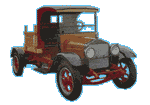Walking Beam Suspensions
Those of you who have been around the truck maintenance business for a long time have seen plenty of walking beam suspensions. These were the first popular tandem-axle designs. The suspension incorporates two equalizing or walking beams, one on each side of the truck, that pivot at the center point onbushings, usually made of rubber. The walking beams are connected by a crossover tube and each beam is supported by a leaf-spring pack or rubber load cushions to absorb road shock and rovide stability. The design distributes weight evenly over the two
rear axles and provides the articulation needed to keep all the wheels on the ground over uneven terrain. Hendrickson Truck Suspension Systems' RT series, with its characteristic leaf-spring pack above the walking beam, was the industry standard on vocational trucks and tractors for more than 70 years. The design has been updated and remains a solid performer, both for on and off road wwork applications.
LEAF SPRINGS
Spring packs are mounted on saddle assemblies and are connected to spring hangers at the front ends with spring eye pins. The
rear ends of the springs have no rigid attachment and move forward and backward as the spring deflection changes. Periodically check all leaves and spring clips for cracks and other damage. Also, inspect each frame hanger. Replace any that have developed cracks or have severe rust. Hendrickson recommends that high mileage springs with one or more leaves broken below the No. 2 leaf be replaced with a new spring assembly of the same part number. Replacing both springs will assure ven spring deflection. Main and wrapperleaves are available as service replacements. The part number is stamped on the spring clips.
An extended-leaf version of the walking beam suspension, with longer top leaves and an additional rear spring hanger, provides two stage spring action for a smooth ride and good stability with a full load,
partial load or when running empty. When empty, the extended leaves
contact outboard spring pads to lower the deflection rate of the springs for asoft ride. With a load, the springs contact the main pads
and provide a higher deflection rate. On Hendrickson RS series suspen-
sions, four rubber load cushions are used in place of leaf springs. The
cushions, available in several durometer hardness ratings for a range f
heavy-duty applications, should be inspected for cuts and swelling at
least once a year. Cushions cut by the retaining lips of the saddles or frame hangers might not be of the correct hardness or configuration for the truck's application or may require rebound control. A rebound ontrol stop kit is available from Hendrickson. Cut or damaged cushions should be replaced, says the manufacturer. Lateral support is provided on Hendrickson vocational suspensions by transverse rods, which transmit lateral loads directly to the frame. This keeps the axle centered laterally and controls axle walkout during cornering.


![]()